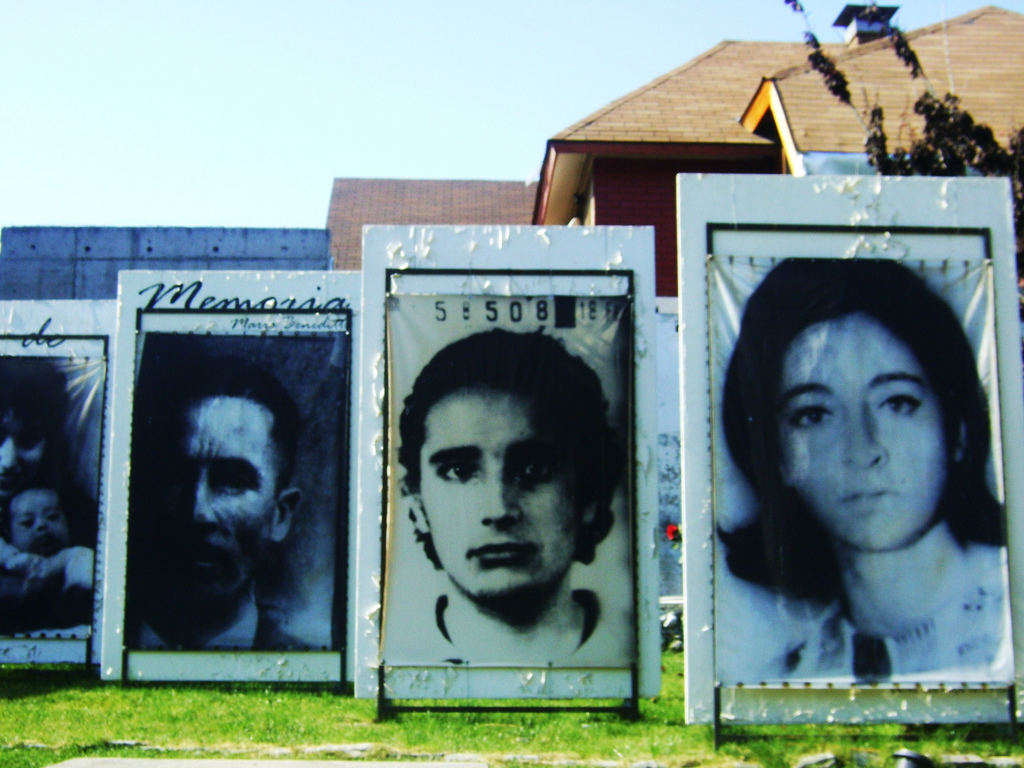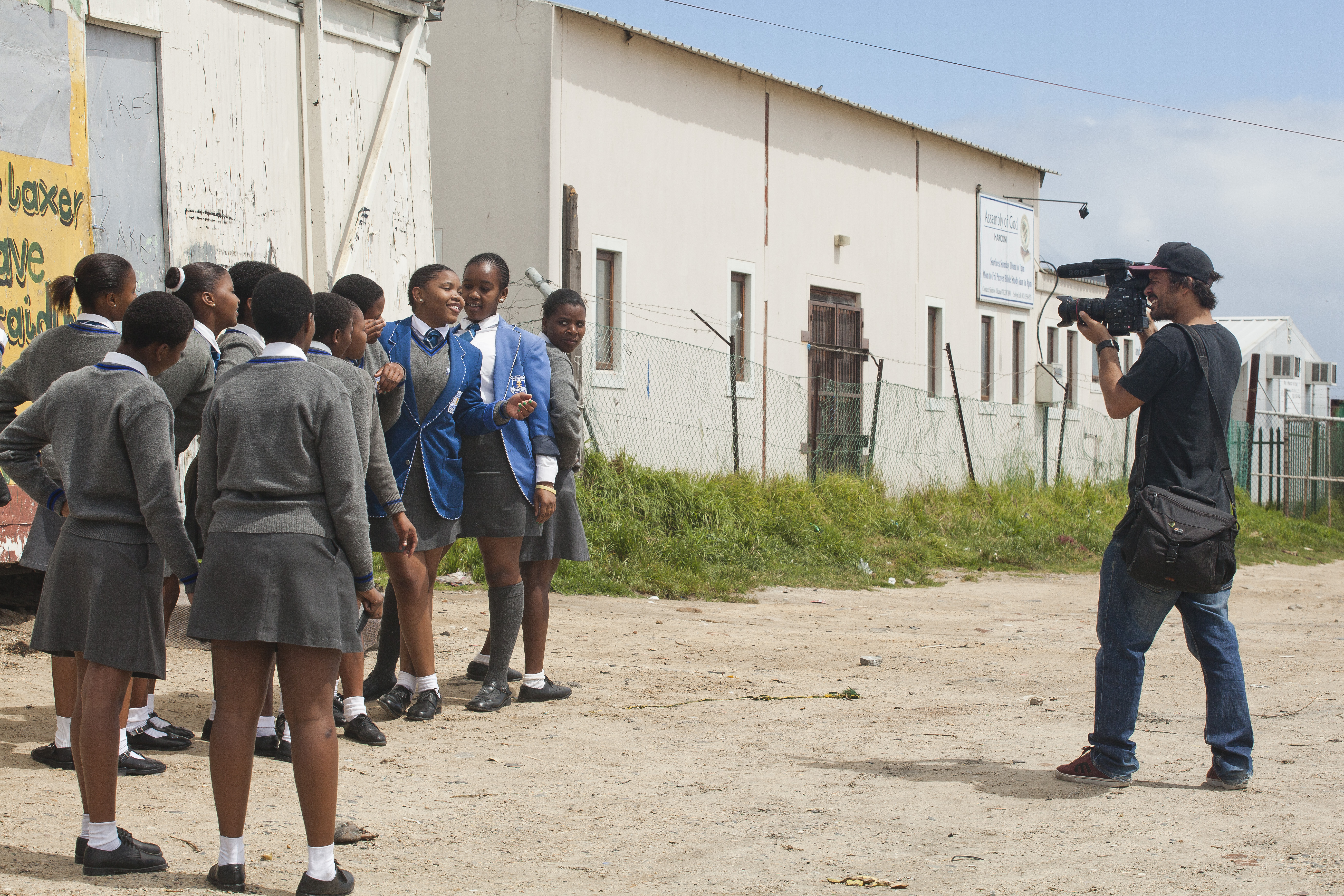|
Cecilia Cacabelos
Cecilia Inés Cacabelos De La Flor (25 November 1958; disappeared 11 October 1976) was an Argentine student kidnapped by security forces on 11 October 1976 during the country's last military dictatorship. Disappearance Cacabelos was detained at the age of 17 by armed men, along with her brother José, while she was in a coffee shop on the Dorrego and Corrientes streets in Buenos Aires. Both were later transferred to the clandestine detention center of the Navy Petty-Officers School (ESMA). Her case was mentioned during the final indictment of the Trial of the Juntas in 1985 by deputy prosecutor Luis Moreno Ocampo Luis Moreno OcampoMoreno Ocampo's surnames are often hyphenated in English-language media to mark Moreno as a surname, not a given name. (born 4 June 1952) is an Argentine lawyer who served as the first prosecutor of the International Criminal .... On 29 June 2013, a commemorative tile in honor of Cecilia was placed at Avenida Corrientes 6195, in the neighb ... [...More Info...] [...Related Items...] OR: [Wikipedia] [Google] [Baidu] |
Buenos Aires
Buenos Aires, controlled by the government of the Autonomous City of Buenos Aires, is the Capital city, capital and largest city of Argentina. It is located on the southwest of the Río de la Plata. Buenos Aires is classified as an Alpha− global city, according to the Globalization and World Cities Research Network, GaWC 2024 ranking. The city proper has a population of 3.1 million and its urban area 16.7 million, making it the List of metropolitan areas, twentieth largest metropolitan area in the world. It is known for its preserved eclecticism, eclectic European #Architecture, architecture and rich culture, cultural life. It is a multiculturalism, multicultural city that is home to multiple ethnic and religious groups, contributing to its culture as well as to the dialect spoken in the city and in some other parts of the country. This is because since the 19th century, the city, and the country in general, has been a major recipient of millions of Immigration to Argentina, im ... [...More Info...] [...Related Items...] OR: [Wikipedia] [Google] [Baidu] |
Argentina
Argentina, officially the Argentine Republic, is a country in the southern half of South America. It covers an area of , making it the List of South American countries by area, second-largest country in South America after Brazil, the fourth-largest country in the Americas, and the List of countries and dependencies by area, eighth-largest country in the world. Argentina shares the bulk of the Southern Cone with Chile to the west, and is also bordered by Bolivia and Paraguay to the north, Brazil to the northeast, Uruguay and the South Atlantic Ocean to the east, and the Drake Passage to the south. Argentina is a Federation, federal state subdivided into twenty-three Provinces of Argentina, provinces, and one autonomous city, which is the federal capital and List of cities in Argentina by population, largest city of the nation, Buenos Aires. The provinces and the capital have their own constitutions, but exist under a Federalism, federal system. Argentina claims sovereignty ov ... [...More Info...] [...Related Items...] OR: [Wikipedia] [Google] [Baidu] |
National Reorganization Process
The National Reorganization Process ( PRN; often simply , "the Process") was the military dictatorship that ruled Argentina from 1976 to 1983. In Argentina it is often known simply as the ("last military junta"), ("last military dictatorship") or ("last civil–military dictatorship"), because there have been several in the country's history and no others since it ended. The Argentine Armed Forces seized political power during the March 1976 coup against the presidency of Isabel Perón, the successor and widow of former President Juan Perón, at a time of growing economic and political instability. Congress was suspended, political parties were banned, civil rights were limited, and free market and deregulation policies were introduced. The President of Argentina and his ministers were appointed from military personnel while Peronists and leftists were persecuted. The junta launched the Dirty War, a campaign of state terrorism against opponents involving torture, extrajudi ... [...More Info...] [...Related Items...] OR: [Wikipedia] [Google] [Baidu] |
Clandestine Detention Center (Argentina)
The clandestine detention, torture and extermination centers, also called (in Spanish: ''centros clandestinos de detención, tortura y exterminio'', CCDTyE —or CCDyE or CCD—, by their acronym), were secret facilities (ie, black sites) used by the Armed, Security and Police Forces of Argentina to torture, interrogate, rape, illegally detain and murder people. The first ones were installed in 1975, during the constitutional government of María Estela Martínez de Perón. Their number and use became generalized after the coup d'état of March 24, 1976, when the National Reorganization Process took power, to execute the systematic plan of enforced disappearance of people within the framework of State terrorism. With the fall of the dictatorship and the assumption of the democratic government of Raúl Alfonsín on December 10, 1983, the CCDs ceased to function, although there is evidence that some of them continued to operate during the first months of 1984. The Armed Forces ... [...More Info...] [...Related Items...] OR: [Wikipedia] [Google] [Baidu] |
Navy Petty-Officers School
The Higher School of Mechanics of the Navy of Argentina (Spanish: ''Escuela Superior de Mecánica de la Armada'', commonly referred to by its acronym ESMA) has gone through three major transformations throughout its history. Originally ESMA served as an educational facility of the Argentine Navy. The original ESMA was a complex located at 8151 Libertador Avenue, in the Autonomous City of Buenos Aires, in the ''barrio'' of Núñez. Additionally, It was the seat of U.T.3.3.2—Unidad de Tareas ( Task Unit) 2 of G.T.3.3 s However, ESMA later operated as an illegal, secret detention center for opponents of the 1976–1983 military dictatorship, described as "subversives" during what was described as the Dirty War. The military took the babies born to mothers imprisoned there, suppressed their true identities, and allowed military families and associates of the regime to illegally adopt them. The Unidad de Tareas ( Task Unit) was responsible for thousands of instances of forced dis ... [...More Info...] [...Related Items...] OR: [Wikipedia] [Google] [Baidu] |
Trial Of The Juntas
The Trial of the Juntas () was the judicial trial of the members of the ''de facto'' military government that ruled Argentina during the dictatorship of the '' Proceso de Reorganización Nacional'' (''el Proceso''), which lasted from 1976 to 1983. It is so far the only example of such a large scale procedure by a democratic government against a former dictatorial government of the same country in Latin America. The Trial of the Juntas began on 22 April 1985, during the presidential administration of Raúl Alfonsín, the first elected government after the restoration of democracy in 1983. The main prosecutors were Julio César Strassera and his assistant Luis Moreno Ocampo (who would go on to become the first Chief Prosecutor of the International Criminal Court). The trial was presided over by a tribunal of six judges: León Arslanián, Jorge Torlasco, Ricardo Gil Lavedra, Andrés D'Alessio, Jorge Valerga Aráoz, and Guillermo Ledesma. Those on trial were: Jorge Rafael Vi ... [...More Info...] [...Related Items...] OR: [Wikipedia] [Google] [Baidu] |
Luis Moreno Ocampo
Luis Moreno OcampoMoreno Ocampo's surnames are often hyphenated in English-language media to mark Moreno as a surname, not a given name. (born 4 June 1952) is an Argentine lawyer who served as the first prosecutor of the International Criminal Court (ICC) from 2003 to 2012. Previously, he had played a major role in Argentina's democratic transition (1983–1991). Judicial highlights As first prosecutor of the International Criminal Court, his mandate was to establish the Office of the Prosecutor and decide where to initiate the first investigations. Under his mandate, the Office of the Prosecutor analyzed 17 situations around the world and opened investigations in seven different countries. He successfully prosecuted for crimes against humanity three heads of state, including the president of Sudan, Omar al-Bashir. At the age of 32, Luis Moreno Ocampo became deputy prosecutor of the Trial of the Juntas, where those most responsible for the National Reorganization Process we ... [...More Info...] [...Related Items...] OR: [Wikipedia] [Google] [Baidu] |
1958 Births
Events January * January 1 – The European Economic Community (EEC) comes into being. * January 3 – The West Indies Federation is formed. * January 4 ** Edmund Hillary's Commonwealth Trans-Antarctic Expedition completes the third overland journey to the South Pole, the first to use powered vehicles. ** Sputnik 1 (launched on October 4, 1957) falls towards Earth from its orbit and burns up. * January 13 – Battle of Edchera: The Moroccan Army of Liberation ambushes a Spanish patrol. * January 27 – A Soviet-American executive agreement on cultural, educational and scientific exchanges, also known as the "Lacy-Zarubin Agreement, Lacy–Zarubin Agreement", is signed in Washington, D.C. February * February 1 – Egypt and Syria unite to form the United Arab Republic. * February 2 – The ''Falcons'' aerobatic team of the Pakistan Air Force led by Wg Cdr Zafar Masud (air commodore), Mitty Masud set a World record loop, world record performing a 16 aircraft diamon ... [...More Info...] [...Related Items...] OR: [Wikipedia] [Google] [Baidu] |
Peronists
Peronism, also known as justicialism, is an Argentine ideology and movement based on the ideas, doctrine and legacy of Juan Perón (1895–1974). It has been an influential movement in 20th- and 21st-century Argentine politics. Since 1946, Peronists have won 10 out of the 14 presidential elections in which they have been allowed to run. Peronism is defined through its three flags: "economic independence" (an economy that does not depend on other countries, by developing its national industry), "social justice" (the fight against socioeconomic inequalities) and " political sovereignty" (the non-interference of foreign powers in domestic affairs). Peronism as an ideology is described as a social form of nationalism, as it pushes for a sense of national pride among Argentines. However, it promotes an inclusive form of nationalism that embraces all ethnicities and races as integral parts of the nation, distinguishing it from racial or chauvinistic ethno-nationalism that priorit ... [...More Info...] [...Related Items...] OR: [Wikipedia] [Google] [Baidu] |
Enforced Disappearances In Argentina
An enforced disappearance (or forced disappearance) is the secret abduction or imprisonment of a person with the support or acquiescence of a state followed by a refusal to acknowledge the person's fate or whereabouts with the intent of placing the victim outside the protection of the law. Often, forced disappearance implies murder whereby a victim is abducted, may be illegally detained, and is often tortured during interrogation, ultimately killed, and the body disposed of secretly. The party committing the murder has plausible deniability as there is no evidence of the victim's death. Enforced disappearance was first recognized as a human rights issue in the 1970s as a result of its use by military dictatorships in Latin America during the Dirty War. However, it has occurred all over the world. According to the Rome Statute of the International Criminal Court, which came into force on 1 July 2002, when committed as part of a widespread or systematic attack directed at any ... [...More Info...] [...Related Items...] OR: [Wikipedia] [Google] [Baidu] |
Argentine Victims Of Crime
Argentines, Argentinians or Argentineans are people from Argentina. This connection may be residential, legal, historical, or cultural. For most Argentines, several (or all) of these connections exist and are collectively the source of their being Argentine. Argentina is a multiethnic society, home to people of various ethnic, racial, religious, denomination, and national origins, with the majority of the population made up of Old World immigrants and their descendants. As a result, Argentines do not equate their nationality with ethnicity, but with citizenship and allegiance to Argentina. Aside from the indigenous population, nearly all Argentines or their ancestors immigrated within the past five centuries. Among countries in the world that have received the most immigrants in modern history, Argentina, with 6.6 million, ranks second to the United States (27 million), and ahead of other immigrant destinations such as Canada, Brazil and Australia. Ethnic groups Overview ... [...More Info...] [...Related Items...] OR: [Wikipedia] [Google] [Baidu] |
Students In Argentina
A student is a person enrolled in a school or other educational institution, or more generally, a person who takes a special interest in a subject. In the United Kingdom and most commonwealth countries, a "student" attends a secondary school or higher (e.g., college or university); those in primary or elementary schools are "pupils". Africa Nigeria In Nigeria, education is classified into four systems known as a 6-3-3-4 system of education. It implies six years in primary school, three years in junior secondary, three years in senior secondary and four years in the university. However, the number of years to be spent in university is mostly determined by the course of study. Some courses have longer study lengths than others. Those in primary school are often referred to as pupils. Those in university, as well as those in secondary school, are referred to as students. The Nigerian system of education also has other recognized categories like the polytechnics and colleges of ... [...More Info...] [...Related Items...] OR: [Wikipedia] [Google] [Baidu] |





